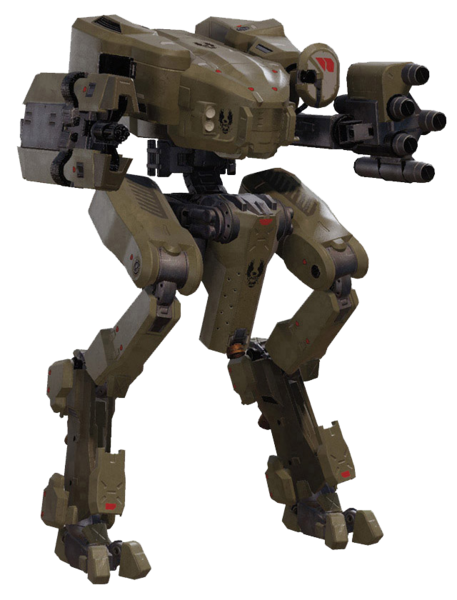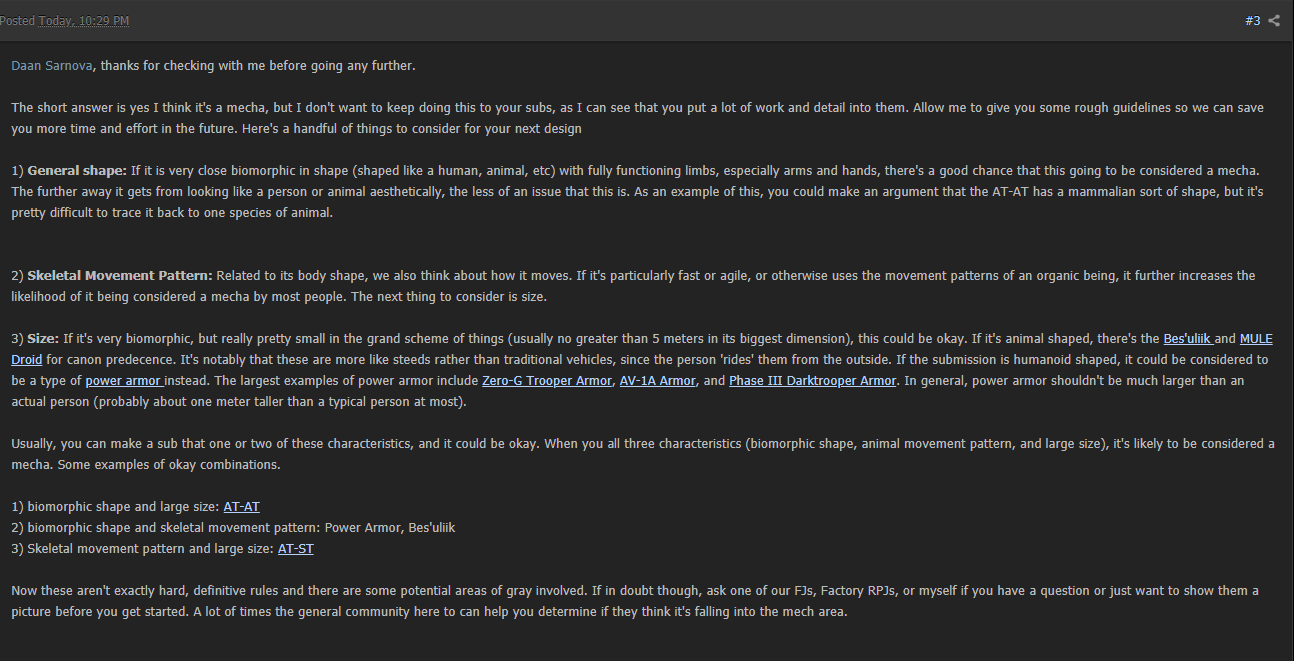Republic Engineering
Artificial Intelligence


| STANDARD CAMO SCHEME - Available to REC Clients | CUSTOM VARIANT - Available via Special Order |

OUT OF CHARACTER INFORMATION
- Intent: To create an advanced and mechanized Battleframe.
- Image Source: Mark IX Armor Defense System | Halopedia / Republic Engineering Corporation's Logo.
- Canon Link: Not Applicable.
- Permissions: Not Applicable.
- Primary Source: Repurposed Canon Articles, Artificial Intelligence System, All-Terrain Scout Transport, Dark Trooper Exosuit.
- Manufacturer: Republic Engineering Corporation; Centax II Surface Facilities, and Deep Space Fabricators.
- Affiliation: Closed-Market.
- Model: REC-MB/01 Advanced Mechanized Battleframe; Laigrek Pattern.
- Modularity: Yes;
- External Enamel Coating.
- Additional and Externally-mounted Modules.
- Production: Limited-scale Production.
- Material:
- Carbon-Durasteel Hull and Armour Plating (Ablative) with Secondary Turadium Armour Plating.
- Alusteel Skeletal Frame, with Laminanium Structural Plating.
- Heavily Reinforced Duraplast Hull Liner with Anti-Ionic Mesh (Faraday Cage.)
- Dallorian Alloy and Agrinium Panels (Where Appropriate.)
- Myoflex Heat Sinks.
- Laser-Reflective Armour Plating.
- Various Vehicle Components.
- Classification: Advanced Battleframe.
- Secondary Classification: Mechanized Assault Walker (Size and Propulsion Patterns.)
- Role: Aggressive reconnaissance, Mobile Weapons Platform, Mobile Infantry Support, Etc.
- Size: Average Rating.
- Length: 3 Metres.
- Width: 6 Metres.
- Height: 6 Metres.
- Weight: 8 Metric Tonnes, or 8,000 Kilograms - Very Heavy Rating.
- Armaments: High Rating.
- One Heavy Rotary Particle Chainblaster [Dedicated Power Supply.]
- One Concussion Grenade Launcher, with Five Mass-driven Tubes [Variable Payload; Auto-loading Functionality.]
- Two Brilliant Nanomissile Blister Pods [Concealed and Retractable, 30 Single-Use Concussion Missiles.]
- Two Repeating Blaster Cannons [Fixed-forward, Chin-mounted.]
- Four Variable Canister Launcher Turrets [Retractable; Two in the Front and Back.]
- External Conductive Polymers / Stun Panels - Integrated Harm Setting(s.)
- Defences: High Rating.
- Heavily Reinforced Armour Plating, with Secondary Turadium Plates and Blast Shields.
- Advanced Deflector Shield, with Integrated Emitters and Generators. (Overlaid Ray, Particle, and Concussion Barriers.)
- Standard Energy-charged Ablative Plating.
- Reinforced Ionic Shielding.
- Advanced EWAR, Electronic Countermeasures, Chaff and Flare Launchers.
- Maneuverability Rating: 60 DPF - Average Rating.
- Speed Rating: 75 Km/H (Maximum Speed, Flat Terrain) - Average Rating.
- Propulsion: Bipedal Locomotion (AT-ST comparable,) with Non-Standard Repulsorlift Modules.
- Minimum Crew: One Operator and One Integrated Droid Brain with A.I Functionality.
- Optimal Crew: One Operator and One Integrated Droid Brain with A.I Functionality.
- Passenger Capacity:
- None.
- Cargo Capacity: 40 Kilograms - Very Small Rating - Maintenance, Survival Equipment, Additional Fuel and Various Munitions.
- Advanced Servomotors, with Gyroscopic Stabilization System.
- Standard Fusion Drive System(s.)
- Standard Compact Fusion Power Plant.
- Standard Hazard and Damage Control Systems.
- Standard Life Support System(s).
- Standard Navigational System(s), Ground-Penetrating Sensors (Hazardous Terrain).
- Advanced Combat Sensors and Targeting System(s). [Including Ground-Penetrating Sensors.]
- Standard Communications System.
- Holonet Transceiver with Encryption/Decryption Networks [Military Encryption Keys.]
- Standard Environmental Control System(s).
- Stabilized Torso with External Armament Armatures.
- Elevation Capable (60') with Lateral Spin (140') Limitations.
- Armature Movement - Linked with Cockpit's Elevation and Lateral Spin Limitations.
- Additional Functionality: Armatures come with Storage Functionality; Locked Otherwise.
- Integrated Droid Brain with Heuristic Processors, and Neural Interface Functionality.
- Various Utility Rails for External Stowage.
- Integrated and Retractable Floodlights, with Various Visual Frequencies and Settings.
- High-Comfort Impact Foam Padding for Bucket Seats.
- Non-Humanoid Momentum - Conventional Combat Walker Movement Patterns.
- Compactable; Reduced Storage and Carrying Capacity.
- Integrated Bio-Conversion Power Generator (Secondary,) with Solar Ionization Collection Arrays and Power Cells; Retractable Access Panels.
- Capable of turning Hydrogen-rich Substances into Useable Fuel; Water, etc.
- Missile Deactivation Transmitter (Short-Range.)
- Anti-Ordnance EM Probe (Long-Range.)
- Anti-Laser Aerosol Launchers.
- Aural-Biological-Chemical Scrambler.
- Highly Automated with a Comprehensive Countermeasure Suite.
- Partially Autonomous - Can be Remotely Operated and Navigate Terrain towards Designated Waypoints.
- Anti-Personnel Specialty; Capable of Engaging Massed Infantry in a Various Environments.
- Optional - External Repulsorlift Module(s); Limited Jump/Flight/Dash Capacity.
- Highly Automated; System and Some Combat Functionality will be Significantly Reduced if Ionic Shielding is Overloaded.
- Limited EMP and Ion Resistance; Device Proximity and Potency Dependent.
- Torso Limitations - Forced to Reorient to Target Hostiles Behind the Battleframe.
- Knockdown Danger - Requires External Modules to Get Back Up.
- Neural Interface - Possible Neural Overload with High Potency EMP and Ionic Devices.
- Non-Humanoid Momentum - Conventional Combat Walker Movement Patterns (AT-ST Comparable.)
- Spindly Limbs - Appendages can be Severed with Enough Force; Crippling the Battleframe.
- Anti-Infantry Specialty - Limited Vehicular Engagement Options.
- Optional - Repulsorlift Jammers; Incapable of Utilizing External Modules.
The REC-AMB/01 Advanced Mechanized Battleframe; Laigrek Pattern was an oddity. It was designed to be an advancement in Powered Armour, but also found itself bequeathed with a secondary classification that set it apart from it’s smaller kin. The Laigrek was considered by many to be a Mechanized Walker, much like the infamous All-Terrain Scout Transport, but was blessed with maneuverable armatures and a more balanced structure. This confusion allowed for the Republic Engineering Corporation to take advantage of the situation and offer their Clients something wholly new, and never seen before. Thus, the Laigrek became the first advanced and mechanized Battleframe's to hit the market, proudly produced by the greatest Interstellar Shipwright this side of the Core Region.
At its core, the Laigrek was an advanced form of a Battleframe - a sort of wearable weapons platform that, in many ways, operated like a personal vehicle. The overall design wasn’t anything like traditional powered armour, or even the ancient Battleframes themselves. For it didn’t cloak an organic’s frame with micronized servos or electro-reactive fibres, or turn them into a walking turret. Instead, it swaddled the Operator in an armoured cradle and lifted them beyond the reach of the surface. This meant that there was considerably more armour plating between the horrors of the outside world, and the Operator themselves. What made the Laigrek unique, aside from it’s hybridized classification, was that the integrated cradle was outfitted with an advanced neural interface. This addition to the Battleframe’s design would allow for the complex controls of conventional walkers to be streamline, and condensed into a simplified format.
As the Project moved towards the final stages of conceptual completion, some concern was aroused in regards to the external armatures. While initially touted as maneuverable, which came with the implication of a limited range of motion - there were those that wanted an expansion on it’s functionality. Mostly for classification purposes, as there were some that made erroneous comparisons to Balmorran War Droids. So, the design team extrapolated on the Battleframe’s functionality by touting the function of the armatures. They weren’t articulated in the same fashion that a Droid’s arm was built to mimic the Organic limb, but rather meant to better store the Laigrek when not in use.
Additionally, the functionality of the armatures were hard-linked to the movement of the chassis/cradle, which added to it’s Industrial and Insectoid appearance, as well as limiting the overall range of motion. While some of the design team weren’t fans of the limitations, as they enjoyed the thought of a Piloted Droid, they were put in place to ensure the gyroscopic stabilization system, alongside it's mechanized movement patterns, would work to the fullest degree. With less parts flailing about, there was a significantly reduced chance of the Laigrek being knocked over during battle, which would doubtlessly cause enough issues for the Operator within the cradle, should that eventuality come to pass.
In many ways, the Laigrek’s technical foundations were formed in the distant past with the successive iterations of the Dark Trooper Project. While the first two phases were advanced battle droids in their own right, the third phase was a hybridized design. From what could be salvaged from the degraded vaults of history, the third phase was a combination of an exosuit and a droid. It was believed that while the suit could be worn like powered armour, the third phase was capable of operating without its organic operator, much like it’s predecessors and the myriad models that sought to capture it’s storied legacy. The Laigrek, while sharing many design similarities, sadly the Battleframe couldn’t operate like a traditional battle droid without an Organic Operator inside.
It was a design feature of the Battleframe, as to allow the semi-sapient A.I. full reign of the platform would’ve been an error that might’ve resulted in catastrophe.
Nevertheless, when operated by an Organic the Laigrek would become a danger to almost everything that stood in its destructive path. Especially since the Battleframe was equipped with a selection of weapons that made the platform wholly dangerous to massed formations of Infantry, as well as Fortified Emplacements and Light Vehicles. Those that could resist the Laigrek’s onslaught were heavily-armoured and armed vehicles, and mechanized Infantry - as they were doubtlessly equipped with the tools needed to survive. However, even with their formidable defences, there was a chance for even the most heavily armoured opposition to fall before the Battleframe's might.
The Laigrek was an expensive gamble. But, if the Battleframe was popular and did well on the market - it was likely to see a proverbial lifetime of support, and successive generations. With that being said, however, the design team at Republic Engineering sought to sweeten the pot in a fashion. The first module, ever to be made for the Laigrek, was a pair of specialized Repulsorlift Engines that would be mounted at the rear of the hybridized design. These modules would grant the Laigrek the ability to defy a Planet’s gravity for a brief measure of time, which took the form of either flight, or a sudden boost to it’s forward momentum. With such an addition, the Mechanized Battleframe would truly become a force to be reckoned with.
One, that might even change the future of modernized warfare.
Last edited:









